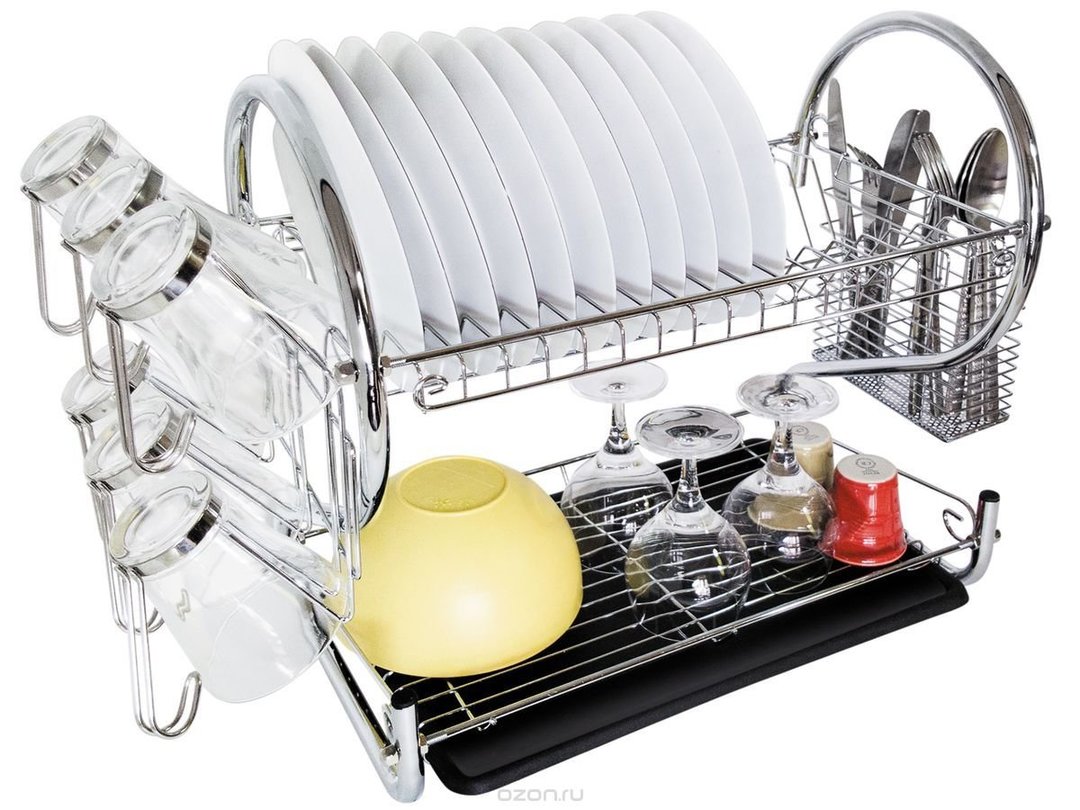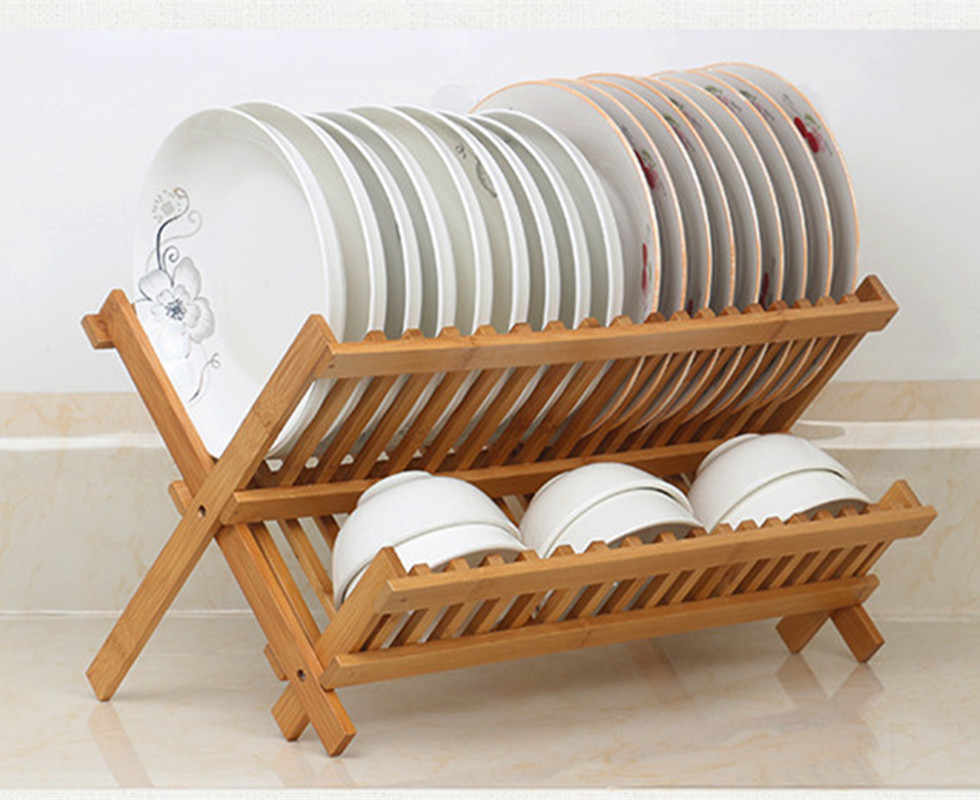The washed dishes can be wiped dry first and then stacked. But why waste precious minutes if special dryers for wet cups and plates have long been invented?! In them, the dishes are not just dried, but stored until one or another item is needed.

Of course, no one forbids, as in the old days, the use of a fence for drying dishes. But fortunately, modern kitchen helper makers are more resourceful than their ancestors. And the hostesses prefer not to leave the house for this. At the same time, they are also “capricious”: either the color of the dryer is not the same, the shape is not the same, or it does not fit into the concept of the room.
The reasons for these "whims" deserve attention. After all, a correctly chosen model of a much-needed kitchen attribute is not only a competent organization of the workspace, but also an element of the interior.
We will tell you how to make the right choice.
Dryers are different ...
The content of the article
-
Dryers are different ...
- Embedded
- Suspended
- Tabletop
-
What material to choose
- Metallic
- Plastic
- Wooden
- Other options
-
The ideal dryer is different for everyone: how to choose
- We are looking for a model with a pallet
- Determining the place
- Choosing the type of construction
- We take into account the volumes of dishes
This is easy to be convinced of: just go to the store or look at the websites of manufacturers and sellers. But if you take a closer look at the assortment, it turns out that there are not so many main types. Today they use 3 types such devices:
- built-in;
- suspended;
- separate systems (desktop).
Embedded
Such models become an integral part of the overall system of kitchen furniture. And, in turn, they are divided into stationary and retractable.

- Stationary it is customary to fix inside the kitchen cabinet above the sink.
- Retractable - hide under it in a drawer.

Reference. There are built-in models specially designed for corner cabinets.

Suspended
Another name for such devices is wall-mounted. They mounted directly on the wall or suspended from the roof rails.

Their advantage is the ability to send plates to dry without leaving the sink.
Reference. Such designs are created for miniature kitchens, in which there is no room either in cabinets or on countertops.
A significant disadvantage of open structures is the lack of protection from dust.
Tabletop
These systems are designed for installation on a table or sink. They tend to impressive size, equipped with legs.

Most often they have two tiers: one for plates, the other for cups. Of course, there are one- and three-tiered models. And also those that allow you to dry any kitchen utensils, up to cutlery.
Interesting! There is also an alternative option: the Troflex dryer. This is a mesh or grate that is placed on top of the sink. You can put both dishes and fruits and vegetables on it, the water from which flows directly into the sink.
What material to choose
The usual materials for manufacturing are considered metal, plastic and wood.
Metallic
The advantages of metal products include them durability and ease of care. But they most expensive.

Yes, and metal to metal strife. The most popular option is stainless steel. It is resistant to mechanical damage and does not corrode. Almost as good aluminum. But over time, it sags or loses color brightness.
reference! Discoloration of the aluminum does not affect the functionality of the dryer.
Normal metal coated with paint or chrome, has a presentable appearance. But from constant contact with water, the protective coating is destroyed. Over time, rusty spots appear on the surface. This is not only untidy, but also unpleasant: the dishes from such a dryer will be dry, but dirty.
There are designs rubber coated. Their main advantage is noiselessness.
Plastic
It is impossible to expect that plastic will last as long. Most often plastic dryers have the most attractive appearance, but this is their only advantage.

In operation they turn out to be unreliable, under the weight of the dishes, they quickly deform or break. But, given the value for money, plastic ones are not a pity to throw away as soon as they cease to fit into the surrounding space.
Wooden
Wooden are considered the most environmentally friendly. But they are quite massive, require a lot of space and swell from constant moisture without proper care.

Other options
There are also dryers made of silicone, rubber or microfiber. The last option is interesting in that it is made in the form of a rug, which, after use, can be easily folded or folded. All in all, this is a great addition to your existing dryer. Such a thing will help out when you need to prepare many sets of dishes for meeting guests.

How to be picky customers if any drying has at least one drawback, but it does? You can listen to someone's advice or act spontaneously: "I will buy what I like." This approach to buying is not the best.
It is preferable to take into account several parameters while in your own kitchen, armed with a measuring tape and a piece of paper with a pencil for writing.
The ideal dryer is different for everyone: how to choose
"Everyone chooses for himself ..." - the words of the poet Yu. Levitansky are relevant even when buying a dryer!
We are looking for a model with a pallet
It is imperative to take into account the stability and the presence of a pallet. Some tiered structures can turn over under the weight of the cookware. And the lack of a pallet leads to additional hassle of collecting the flowing water.

Determining the place
Further - everything is individual. In order for an incorrectly selected kitchen accessory not to cause a "headache", it is necessary decide on a placewhere the dryer will go, and measure its length and depth.
These figures are decisive. They show the maximum dimensions of the future structure.

Choosing the type of construction
If you plan to install it inside the cabinet, then the main thing here is functionality. And if the dryer is constantly in sight, then the aesthetic aspect is also important.
Tabletop model manufacturers have made sure that their products fit into a variety of interior solutions.
We take into account the volumes of dishes
The number of dishes is also important.
For small families a single-level dryer is enough. On average amount plates and cups fit devices in two or three levels.

There are a lot of dishes? Not a problem, there are on sale volumetric dryers! They are built into a closet with all shelves, grilles, sections. They fit absolutely everything: knives, and "guest" utensils, and pans with pots!

The choice here is limited only by your own taste and wallet.
Have you already figured out which dryer you need?